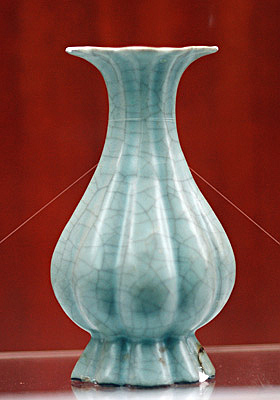|
 |
 |
|
ANCIENT TRADING: An exhibition of China's porcelain ware produced for export during the Qing Dynasty (1644-1911) is held in Beijing in February 2010 (LUO XIAOGUANG) |
PORCELAIN TREASURES: A green glazed porcelain vase of the Song Dynasty (960-1279) (CFP) |
Porcelain is generally believed to have originated in China, the reason it is also called "china" in the West. The production of pottery in China dates back some 10,000 years.
Development
Proto-celadon, predecessor of porcelain and the transition state from pottery to porcelain, appeared during the Shang and Western Zhou dynasties (1600-771 B.C.), and porcelain production started no later than the Eastern Han Dynasty (25-220).
Since the 1970s, a number of celadon shards featuring delicate textures and glossy glazes were unearthed from the Han Dynasty (202 B.C.-A.D. 220) kiln sites in south China. Porcelain ware in varied shapes was also found in tombs of that period, showing high-firing glazed pottery had developed into porcelain by that time.
During the 300-odd years following the Han Dynasty, in comparison with the war-ridden north China, the area of the lower reaches of the Yangtze River was much more stable, favoring the development of porcelain making.
Great numbers of kilns were built in Shaoxing, Yuhang and Wuxing—all in today's Zhejiang Province—where similar types of porcelain were produced, which helped to form the style of the Yue Kiln. Kilns in this area mostly produced celadon and black porcelain. In the late Western Jin Dynasty (265-316), green glazed porcelain decorated with brown spots was also produced there.
The porcelain of this style featured hard and fine roughcast and was light grey in color. The types of products expanded too, including bowls, trays, saucers, platters, jars, pots, incense burners and candlesticks.
When Buddhism prevailed in the Southern Dynasties (420-589), porcelain products were typically decorated with lotus flowers.
Besides the Yue Kiln, other noted porcelain kilns in the south of the country included the Deqing Kiln (Zhejiang Province), Wuzhou Kiln (Zhejiang Province), Xiangyin Kiln (Hunan Province) and Fengcheng Kiln (Jiangxi Province).
Compared to the south, porcelain production started a little later in the north. As a result of low iron content in kaolin in the north, mostly white porcelain was produced there. Four green glazed porcelain vessels with lotus patterns unearthed from a tomb in today's Hebei Province are rated as representative works of north China's porcelain produced in that period and show fine art in their making.
The ceramic industry in China reached a new stage during the Sui and Tang dynasties and the period of Five Dynasties and Ten Kingdoms, which lasted from 518 to 960.
Kilns in the south, with the Yue Kiln as their centerpiece, enjoyed a reputation for celadon porcelain production, while kilns in the north, with Xing Kiln (Hebei Province) as a representative, became known for their white porcelain.
| 